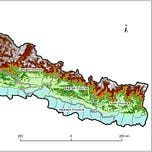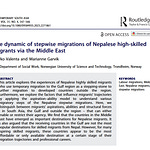Theme: Environmental Governance and Policy Reform Authors: Pashupati Nepal, Basanta Paudel, Yili Zhang, Narendra Raj Khanal, Linshan Liu, Mohan Kumar Rai, Nirdesh Nepal Journal: Geography and Sustainability Published: 2025 (pre-proof) Language: English DOI: 10.1016/j.geosus.2025.100263Introduction
This review summarizes and reflects on the 2025 research paper assessing Nepal’s ecosystem governance through a systematic appraisal of 63 policy and legislative documents, supported by 20 expert interviews. The study provides critical insights into the current state of ecosystem service governance, highlighting fragmentation, overlapping mandates, and weak implementation capacity in Nepal.
Paper Overview
The research is organized around three main questions:
The historical growth and trends in Nepal’s ecosystem-related policies and legislation
The extent of ecosystem service integration into these frameworks
The institutional mechanisms and their effectiveness across governance tiers
Key Areas Covered
1. Growth in Policies and Legislation
63 documents reviewed (45 policies, 18 pieces of legislation) from 1990 to 2020.
A sharp rise in policies post-2015 Constitution, with increasing integration of ecosystem services (ES) concepts.
2. Thematic and Sectoral Coverage
Most policies emphasize provisioning (73.3%) and regulating (57.7%) services.
ES are mainly covered under forestry, biodiversity, agriculture, and water sectors.
Cross-sectoral integration is weak, with many policies covering overlapping sectors without coordination.
3. Institutional Governance Across Government Tiers
Federal government leads in policy formulation (94%), but local and provincial roles are growing.
Weak vertical and horizontal coordination mechanisms hinder implementation.
Fragmentation among ministries leads to duplication, contradiction, and inefficiency.
4. Policy Implementation Challenges
Legislation often lacks clarity on implementation responsibility.
Funding dependence on donors weakens internal ownership.
Human and financial resource gaps exist at local levels.
Key Takeaways
Nepal Has Extensive ES Policies — But Lacks a Unified Framework
Sectoral policies exist, but there’s no central legislation or coordination body guiding ecosystem service governance.
Policy Overlaps Cause Institutional Conflicts
For example, contradictions between the Forest Act and Local Government Act over resource rights hinder clarity.
Local Governments Empowered, But Under-Resourced
Despite constitutional rights, local bodies lack adequate capacity to implement ES management.
Integration of Climate and Ecosystem Policy Still Evolving
Policies since 2010 have begun recognizing climate–ecosystem linkages, but many remain siloed.
Expert Insights
Experts interviewed for the study noted:
Policies are often donor-driven, not based on local priorities.
There is limited coordination between ministries when drafting sectoral policies.
Implementation suffers from unclear mandates and lack of accountability.
Conclusion
This study makes a strong case for an overarching ES governance framework in Nepal — one that:
Clearly defines institutional responsibilities
Builds multi-sectoral coordination
Backs policies with strong legal enforcement mechanisms
Strengthens capacity at the local government level
Nepal’s rich natural ecosystems are under increasing pressure. This research highlights that governance reform — not just ecological conservation — is the missing piece. A national framework with strong coordination, clarity, and capacity-building is urgently needed to ensure the sustainable provision of ecosystem services for generations to come.
Source: https://www.sciencedirect.com/science/article/pii/S2666683925000021









